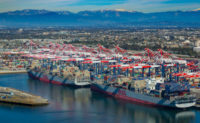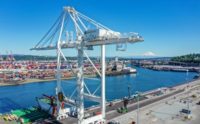Rio Negro Bridge, $400-Million Economic Link, Opens in Amazon Basin






Battling floods, difficult soils and the environmentally sensitive nature of the Amazon rainforest, crews are building a 3,600-meter-long, $400-million bridge with a 400-m-long cable-stayed central section over the Negro River using a 400-barge working platform. The project, marked by a death and environmental controversy, is intended to boost economic development in the Amazon.
Brazil’s Manaus-Iranduba Bridge, scheduled for completion by year’s end, will straddle the river close to where the waterway merges with the Amazon River. The span will create a land link between the city of Manaus and the town of Iranduba as well as 30 other, smaller municipalities.
The country’s fourth-longest bridge is being built by the Rio Negro Consortium, a joint venture of Camargo Corrêa and Construbase. The project is an effort of the Amazonas state government, although funding was acquired through Brazil’s state-owned development bank, known by its Portuguese-language acronym BNDES. Work began in 2008.
The Manaus-Iranduba bridge sits on more than 70 pylons. A central 185-m-high pylon supports the central section, which rises 50 m above the waterline during the rainy season to permit passage of river vessels. The other bridge sections consist of 45-m-long prestressed concrete segments, each weighing about 131 tons.
The contractor drove piles up to 2.5 m in diameter to varying depths into a geologically complex riverbed composed of erratic rock layers. Henrique Barroso Domingues, a Camargo Corrêa project engineer, says that working in the river required an assembly akin to “a war operation.” Coordinating operations and materials both on land and in the water required careful and precise logistics, he says.
Using an assembly of barges and boats as a working platform, crews drove the metal pile casings into the Amazon River tributary and filled them with bentonite mud. After concrete placement, crews retrieved the mud for use in additional piles. Workers monitored the water, looking for oscillations that could compromise the concrete pours. Crews also dealt with a massive flood last year, along with frequent high winds at the site.
Francisco Catão Ribeiro, project engineer with project consultant Enescil Engineering, says each 2.4-m-dia pile required 5 sq m of concrete—a volume pumped by up to 50 concrete truck mixers, all carried on the barges.
The contractor curtailed work on Sept. 28 after one of the three supporting beams between two of the bridge’s pillars fell, killing one worker and injuring three others. The consortium stopped hanging the beams until a preliminary technical report, released on Oct. 11, found the accident was not the result of a structural problem. The contractor continued construction on the bridge deck and approaches during the stoppage.
Manaus has become a major industrial hub in recent years. Regional planners hope the completed bridge will open up a new industrial district in Iranduba. Currently, transport across the river is managed by a fleet of ferries that charge about $60 for the 40-minute passage. Each week, about 2,500 vehicles cross the river.
Environmentalists fear the bridge will foster the destruction of the sensitive Amazon rainforest. One major concern is that the bridge will revitalize efforts to restore the 900-kilometer-long highway south of the river between Manaus and Porto Vehlo in the state of Rondonia. The road, BR-319, opened in 1976 but has been poorly maintained and largely impassable since the early 1990s. The government plans to rebuild the road by 2012 to bolster development in the Amazon basin.
In 2007, the Brazilian government set aside $400 million from an infrastructure stimulus initiative to revitalize the roadway, but the effort stalled when the country’s environmental enforcement agency, IBAMA, refused to issue an environmental license for the project.








